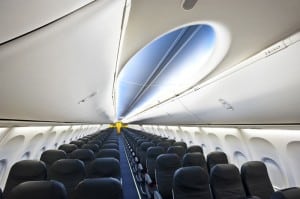Gogo Focuses on Satellite Strategy and International Markets
[Via Satellite 06-23-2014] On June 18, 2014, roughly a year since the company’s Initial Public Offering (IPO), Gogo held its first analyst day near its Itasca, Minn. headquarters outside of Chicago, Ill. Gogo highlighted international markets as a key part of its growth strategy moving forward as airlines scurry to connect their aircraft.
“The number of international proposals that Gogo has submitted in 2014 has increased 400 percent compared with 2013. The company has observed a sense of urgency from airline carriers to select a connectivity provider,” Jim Breen, CFA at William Blair & Company wrote in a research note. “Gogo is targeting achieving contract awards of 500 to 1,000 aircraft by the end of 2015, compared with 332 today. Depending on the contract type, this could imply five to eight new contracts over the ensuing 18 months.”
By the end of 2015, Breen said Gogo is targeting 300 international planes, of which the company has 19 equipped today. As Gogo pursues these numbers, its international business could surpass its domestic business in terms of revenue.
“Gogo is in ‘land-grab mode’ outside the U.S.,” wrote John Hodulik, managing director at UBS. “The addressable market is larger, with total commercial aircraft of approximately 13,000 — only 17 percent of which are committed to an In-Flight Connectivity (IFC) provider — versus approximately 4,000 in the U.S. — 87 percent of which are committed. Management believes [the Rest of the World] (ROW) will eventually generate more revenue than the U.S.”
Gogo currently holds a significant position in the U.S. IFC market through its combination of Air-to-Ground (ATG) towers and accompanying satellite overlay. Recently AT&T and Inmarsat have both expressed intentions of producing their own ATG networks, with AT&T planning to build towers in the U.S. and Inmarsat across the European Union. But despite all the ground activity, Gogo stressed that satellite would play the primary role in its international strategy.
“Gogo highlighted that its long-term commercial strategy is based on satellite technology given the superior bandwidth economics, coverage and ability of satellite to support video,” wrote Andrew Spinola, senior analyst at Wells Fargo, in a research note. “Gogo described ATG as the Model T which helped to launch the market and will continue to be the workhorse of Business Aviation, but is not currently the long-term solution for commercial regardless of ATG spectrum availability.”
Spinola cautioned that the success of Gogo’s Business Aviation segment could attract value-priced competition in the future. The company told analysts that it anticipates the Average Revenue Per User (ARPU) to climb on new products. Breen thinks SMS services could offer more room to grow.
“We believe that SMS text-messaging on aircraft represents a significant new opportunity for Gogo as it opens up a new demographic of passengers. The text messaging app is currently in beta for Android users. The service [is] to come out of beta in 2014. Gogo and the airlines are currently evaluating whether they will offer it via a retail or wholesale model. There is also the potential for Gogo to partner with cellular, social networking, and credit card providers,” Breen wrote.
The company said it averages approximately $110,000 in annual revenue per aircraft for a total of 2,056 commercial plans. Gogo is confident that its new proprietary 2Ku solution will further boost its revenue per aircraft. The 2Ku solution is slated to begin commercial use in 2015 offering 70 Mbps connectivity. The company estimates that revenue could increase to $800,000 per aircraft as the IFC market continues to develop.
